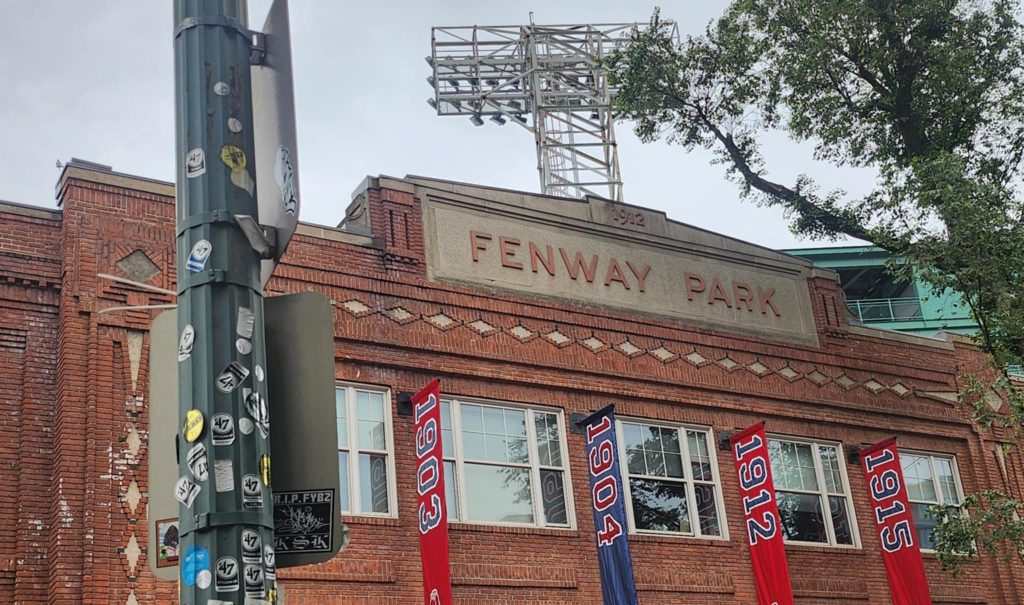[[{“value”:”Fenway Park on the week of workers’ strike authorization. (Working Mass)
By: Andrew S
FENWAY PARK, MA – Concessions workers at the world’s oldest baseball stadium have decided resoundingly to strike for the first time in their 113-year history. On Sunday, June 15, 2025, Fenway Park concessions workers and MGM Music Hall workers across the street officially voted to authorize a strike against their employer, Aramark. The membership of UNITE HERE Local 26 passed authorized the strike with an overwhelming majority of over 95% workers in favor. In their press conference, Local 26 President Carlos Aramayo declared that management “has been nothing but disrespectful” and the “union could go on strike as early as this afternoon.”
On May 15, 2025, UNITE HERE Local 26 officially decided to hold a strike authorization vote a month later if the bargaining committee and Aramark were not able to come to any agreement on wages or technology. They didn’t, forcing workers to strike as a result.
Aramayo cited low wages as one primary reason for authorizing a strike: “The wage structure here is embarrassingly low, not just compared to other jobs in the region but also in comparison to other stadiums in the United States.” Organizers passed around flyers showing that cashiers at the Miami Marlins stadium made $21.25 an hour while beers there only cost $5.19. In contrast, beers at Fenway are sold for $10.79 a pop while workers are only paid $18.51 an hour. Aramark charges fans at Fenway more than any other ballpark in the country, and their workers still make less despite higher costs of living.
The Red Sox are worth $4.8 billion and Fenway was the most expensive stadium to attend a ballgame in 2024. So, you’ve got to wonder – why are workers paid peanuts?
Automating Fenway
Part of it is a broader anti-worker strategy also involving automation. Workers have also noted that a source of tension with Aramark has been with technological changes forced on the workplace at the expense of workers. Aramayo claimed that Aramark had replaced some of Fenway’s highest paying jobs with automatic computer-based systems that recorded sales.
That had two consequences. The first was that a significant amount of opportunities for promotion were eliminated or nullified, which directly impacted workers’ ability to survive rising rent and cost of living. That affected not only their ability to stay on the job, but also embedded in their communities around Boston.
There is another consequence, though – poorer service. During the June 15 press conference, Local 26 member Natalie Green described the labor done by the thousand-strong workforce. On a daily basis, workers perform a variety of tasks that automated technology cannot:
A computer cannot check if you are over-served or underage drinking. The reason why we stay here is that we are good at our jobs and we want to protect the community.
Fenway Park: A Community-Rooted Workforce
Protecting the community is one dimension of Fenway work that comes alive in the hands of the workers. Many workers’ own ties to the park and to each other run deep. Fenway Park concessions workers share a remarkable legacy of working for many years at the park, season after season, bonds that have made labor organizing more effective.
Laura Crystal and Richard Moffat are a couple who work concessions at Fenway, mentioning to Working Mass that both have been working at Fenway since they were in high school. Crystal’s and Moffat’s lives have revolved around the park. They emphasized that this is normal for Fenway workers:
We got married here, we got engaged on the field, and we’re pregnant…this place becomes a part of your DNA. How do we not love this place? It’s so fundamental to us on top of being a job.
Fenway Park on the week of workers’ strike authorization. (Working Mass)
Mass Bargaining and Solidaristic Bonds
Fenway Park employees have used close familial networks as leverage for labor organizing in spite of Aramark’s disdain. President Aramayo noted that there were 75-80 people on the negotiating and organizing committee that spearheaded the campaign amongst workers in Fenway. In other words, a little less than 10% of the entire workforce was represented on the bargaining committee – ensuring that bargaining committee members and workplace leaders could convey and mobilize their networks directly.
Beer-seller Richard Moffat noted that, as a collective with UNITE HERE, Fenway Park workers used their close relationships to bring people on board for the strike vote and stand up to management. “Everyone has a larger network of friends here, and they try to use that to connect us as a large group,” Moffat said. “We all help each other to vote, do actions. We have huddles during check-in to show that we can do this in front of management, and that you’re going to be okay. You’re not going to get into trouble, or sent home, or fired. It’s all about gaining momentum.”
Crystal also chimed in to describe how Fenway’s high-pressure work created ideal conditions to build friendship and, thus, solidarity: “Everyone knows that you don’t know somebody better than when they’re your coworker on their worst day at the job. In there, it’s a hundred degrees, you’re behind a steamer making hot dogs, or running around with drunk fans. It’s a high-pressure situation, and we have strong friendships because of that. Local 26 used those strong friendships to push the message out and hold each other accountable.”
The strong network built among coworkers at Fenway emboldened one another to organize on the shop floor, because workers knew they had each other’s backs – both as individuals and as a union.
Nonetheless, Aramark tipping workers to a boiling point with low wages and automation still leaves a bad taste in his mouth – just like many of his coworkers who have been fixtures of the park for decades. “A lot of us have had to sacrifice a lot to keep up with the high demands and to maintain seniority…it means a lot to us.” Moffat sighed.
We feel like [Aramark is] destroying the sanctity of America’s most beloved ballpark.
Andrew S is a member of Boston DSA and a contributing writer to Working Mass.
Fenway Park on the week of workers’ strike authorization. (Working Mass)
The post 1000 Fenway Park Concessions Workers To Strike For First Time in 113 Years appeared first on Working Mass.
“}]]

